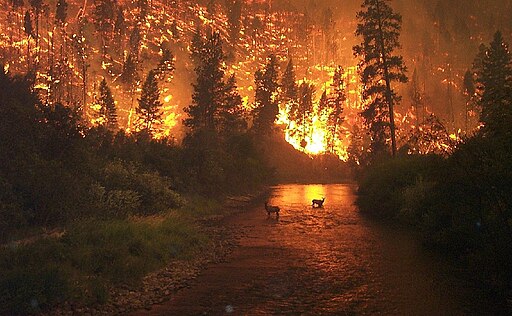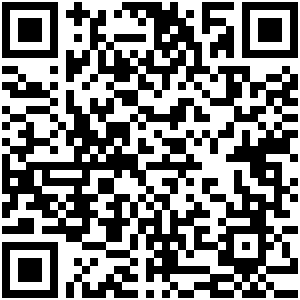 When the Fire Starts
When the Fire Starts
By the National Disaster Education Coalition
More and more people are making their homes in woodland settings - in or near forests, rural areas, or remote mountain sites. There, homeowners enjoy the beauty of the environment but face the very real danger of wildfire.
Every year across our Nation, some homes survive - while many others do not - after a major wildfire. Those that survive almost always do so because their owners had prepared for the eventuality of fire, which is an inescapable force of nature in fire-prone wildland areas. Said in another way - if it's predictable, it's preventable!
Wildfires often begin unnoticed. These fires are usually triggered by lightning or accidents. They spread quickly, igniting brush, trees, and homes. Reduce your risk by preparing now - before wildfire strikes. Meet with your family to decide what to do and where to go if wildfires threaten your area. Follow the steps listed below to protect your family, home, and property
Before a Wildfire
The following are things you can do to protect yourself, your family and your property in the event of a fire.
- To begin preparing, you should build an emergency kit and make a family communications plan.
- Design and landscape your home with wildfire safety in mind. Select materials and plants that can help contain fire rather than fuel it.
- Use fire-resistant or noncombustible materials on the roof and exterior structure of the dwelling, or treat wood or combustible material used in roofs, siding, decking or trim with fire-retardant chemicals evaluated by a nationally recognized laboratory, such as Underwriters Laboratories (UL).
- Plant fire-resistant shrubs and trees. For example, hardwood trees are less flammable than pine, evergreen, eucalyptus or fir trees.
- Regularly clean roof and gutters.
- Inspect chimneys at least twice a year. Clean them at least once a year. Keep the dampers in good working order. Equip chimneys and stovepipes with a spark arrester that meets the requirements of National Fire Protection Association Standard 211. (Contact your local fire department for exact specifications.)
- Use 1/8-inch mesh screen beneath porches, decks, floor areas, and the home itself. Also, screen openings to floors, roof and attic.
- Install a dual-sensor smoke alarm on each level of your home, especially near bedrooms; test monthly and change the batteries at least once each year.
- Teach each family member how to use a fire extinguisher (ABC type) and show them where it's kept.
- Keep handy household items that can be used as fire tools: a rake, axe, handsaw or chain saw, bucket and shovel.
- Keep a ladder that will reach the roof.
- Consider installing protective shutters or heavy fire-resistant drapes.
- Clear items that will burn from around the house, including wood piles, lawn furniture, barbecue grills, tarp coverings, etc. Move them outside of your defensible space.
Plan Your Water Needs
- Identify and maintain an adequate outside water source such as a small pond, cistern, well, swimming pool, or hydrant.
- Have a garden hose that is long enough to reach any area of the home and other structures on the property.
- Install freeze-proof exterior water outlets on at least two sides of the home and near other structures on the property. Install additional outlets at least 50 feet from the home.
- Consider obtaining a portable gasoline powered pump in case electrical power is cut off.
Your best resource for proper planning is www.firewise.org which has outstanding information used daily by residents, property owners, fire departments, community planners, builders, public policy officials, water authorities, architects and others to assure safety from fire - it really works. Firewise workshops are offered for free all across the nation in communities large and small and free Firewise materials can be obtained easily by anyone interested.
Preparing Your Home for a Wildfire
It is recommended that you create a 30 to 100 foot safety zone around your home. Within this area, you can take steps to reduce potential exposure to flames and radiant heat. Homes built in pine forests should have a minimum safety zone of 100 feet. If your home sits on a steep slope, standard protective measures may not suffice. Contact your local fire department or forestry office for additional information.
- Rake leaves, dead limbs and twigs. Clear all flammable vegetation.
- Remove leaves and rubbish from under structures.
- Thin a 15-foot space between tree crowns, and remove limbs within 15 feet of the ground.
- Remove dead branches that extend over the roof.
- Prune tree branches and shrubs within 15 feet of a stovepipe or chimney outlet.
- Ask the power company to clear branches from powerlines.
- Remove vines from the walls of the home.
- Mow grass regularly.
- Clear a 10-foot area around propane tanks and the barbecue. Place a screen over the grill - use nonflammable material with mesh no coarser than one-quarter inch.
- Regularly dispose of newspapers and rubbish at an approved site. Follow local burning regulations.
- Place stove, fireplace and grill ashes in a metal bucket, soak in water for 2 days; then bury the cold ashes in mineral soil.
- Store gasoline, oily rags and other flammable materials in approved safety cans. Place cans in a safe location away from the base of buildings.
- Stack firewood at least 100 feet away and uphill from your home. Clear combustible material within 20 feet. Use only wood-burning devices evaluated by a nationally recognized laboratory, such as Underwriters Laboratories (UL).
- Review your homeowner's insurance policy and also prepare/update a list of your home's contents.
Practice Wildfire Safety
People start most wildfires - find out how you can promote and practice wildfire safety.
- Contact your local fire department, health department, or forestry office for information on fire laws.
- Make sure that fire vehicles can get to your home. Clearly mark all driveway entrances and display your name and address.
- Report hazardous conditions that could cause a wildfire.
- Teach children about fire safety. Keep matches out of their reach.
- Post fire emergency telephone numbers.
- Ensure adequate accessibility by large fire vehicles to your property.
- Plan several escape routes away from your home - by car and by foot.
- Talk to your neighbors about wildfire safety. Plan how the neighborhood could work together after a wildfire. Make a list of your neighbors' skills such as medical or technical. Consider how you could help neighbors who have special needs such as elderly or disabled persons. Make plans to take care of children who may be on their own if parents can't get home.
Follow Local Burning Laws
- Before burning debris in a wooded area, make sure you notify local authorities and obtain a burning permit.
- Use an approved incinerator with a safety lid or covering with holes no larger than ¾ inch.
- Create at least a 10-foot clearing around the incinerator before burning debris.
- Have a fire extinguisher or garden hose on hand when burning debris.
During a Wildfire
If advised to evacuate, do so immediately. Take your disaster supply kit, lock your home and choose a route away from the fire hazard. Watch for changes in the speed and direction of the fire and smoke. Tell someone when you left and where you are going.
If you see a wildfire and haven't received evacuation orders yet, call 9-1-1. Don't assume that someone else has already called. Describe the location of the fire, speak slowly and clearly, and answer any questions asked by the dispatcher.
If you are not ordered to evacuate, and have time to prepare your home, FEMA recommends you take the following actions:
- Arrange temporary housing at a friend or relative’s home outside the threatened area in case you need to evacuate.
- Wear protective clothing when outside – sturdy shoes, cotton or woolen clothes, long pants, a long-sleeved shirt, gloves and a handkerchief to protect your face.
- Gather fire tools such as a rake, axe, handsaw or chainsaw, bucket and shovel.
- Close outside attic, eaves and basement vents, windows, doors, pet doors, etc. Remove flammable drapes and curtains. Close all shutters, blinds or heavy non-combustible window coverings to reduce radiant heat.
- Close all doors inside the house to prevent draft. Open the damper on your fireplace, but close the fireplace screen.
- Shut off any natural gas, propane or fuel oil supplies at the source.
- Connect garden hoses to outdoor water faucet and fill any pools, hot tubs, garbage cans, tubs or other large containers with water.
- Place lawn sprinklers on the roof and near above-ground fuel tanks. Leave sprinklers on and dowsing these structures as long as possible. Be mindful of water use restrictions for areas affected by wildfires.
- If you have gas-powered pumps for water, make sure they are fueled and ready.
- Place a ladder against the house in clear view.
- Disconnect any automatic garage door openers so that doors can still be opened by hand if the power goes out. Close all garage doors.
- Place valuable papers, mementos and anything "you can't live without" inside the car in the garage, ready for quick departure. Any pets still with you should also be put in the car.
- Place valuables that will not be damaged by water in a pool or pond.
- Move flammable furniture into the center of the residence away from the windows and sliding-glass doors.
- Turn on outside lights and leave a light on in every room to make the house more visible in heavy smoke.
Surviving a Wildfire
Survival in a Vehicle
- This is dangerous and should only be done in an emergency, but you can survive the firestorm if you stay in your car. It is much less dangerous than trying to run from a fire on foot.
- Roll up windows and close air vents. Drive slowly with headlights on. Watch for other vehicles and pedestrians. Do not drive through heavy smoke.
- If you have to stop, park away from the heaviest trees and brush. Turn headlights on and ignition off. Roll up windows and close air vents.
- Get on the floor and cover up with a blanket or coat.
- Stay in the vehicle until the main fire passes.
- Stay in the car. Do not run! Engine may stall and not restart. Air currents may rock the car. Some smoke and sparks may enter the vehicle. Temperature inside will increase. Metal gas tanks and containers rarely explode.
If You Are Trapped at Home
- If you do find yourself trapped by wildfire inside your home, stay inside and away from outside walls. Close doors, but leave them unlocked. Keep your entire family together and remain calm.
If Caught in the Open
- The best temporary shelter is in a sparse fuel area. On a steep mountainside, the back side is safer. Avoid canyons, natural "chimneys" and saddles.
- If a road is nearby, lie face down along the road cut or in the ditch on the uphill side. Cover yourself with anything that will shield you from the fire's heat.
- If hiking in the back country, seek a depression with sparse fuel. Clear fuel away from the area while the fire is approaching and then lie face down in the depression and cover yourself. Stay down until after the fire passes!
After a Wildfire
The following are guidelines for different circumstances in the period following a fire:
- Go to a designated public shelter if you have been told to evacuate or you feel it is unsafe to remain in your home. Text SHELTER + your ZIP code to 43362 (4FEMA) to find the nearest shelter in your area (example: shelter 12345).
- If you are with burn victims, or are a burn victim yourself, call 9-1-1 or seek help immediately; cool and cover burns to reduce chance of further injury or infection.
- If you remained at home, check the roof immediately after the fire danger has passed. Put out any roof fires, sparks or embers. Check the attic for hidden burning sparks.
- For several hours after the fire, maintain a "fire watch." Re-check for smoke and sparks throughout the house.
- If you have evacuated, do not enter your home until fire officials say it is safe.
- If a building inspector has placed a color-coded sign on the home, do not enter it until you get more information, advice and instructions about what the sign means and whether it is safe to enter your home.
- If you must leave your home because a building inspector says the building is unsafe, ask someone you trust to watch the property during your absence.
- Use caution when entering burned areas as hazards may still exist, including hot spots, which can flare up without warning.
- If you detect heat or smoke when entering a damaged building, evacuate immediately.
- If you have a safe or strong box, do not try to open it. It can hold intense heat for several hours. If the door is opened before the box has cooled, the contents could burst into flames.
- Avoid damaged or fallen power lines, poles and downed wires.
- Watch for ash pits and mark them for safety—warn family and neighbors to keep clear of the pits also.
- Watch animals closely and keep them under your direct control. Hidden embers and hot spots could burn your pets’ paws or hooves.
- Follow public health guidance on safe cleanup of fire ash and safe use of masks.
- Wet debris down to minimize breathing dust particles.
- Wear leather gloves and heavy soled shoes to protect hands and feet.
- Cleaning products, paint, batteries and damaged fuel containers need to be disposed of properly to avoid risk.
- Discard any food that has been exposed to heat, smoke or soot.
- Do NOT use water that you think may be contaminated to wash dishes, brush teeth, prepare food, wash hands, make ice or make baby formula.
- Remain calm. Pace yourself. You may find yourself in the position of taking charge of other people. Listen carefully to what people are telling you, and deal patiently with urgent situations first.
Hazards After Wildfires: Flood and Landslides
You may be at an even greater risk of flooding due to recent wildfires that have burned across the region. Large-scale wildfires dramatically alter the terrain and ground conditions. Normally, vegetation absorbs rainfall, reducing runoff. However, wildfires leave the ground charred, barren, and unable to absorb water, creating conditions ripe for flash flooding and mudflow. Flood risk remains significantly higher until vegetation is restored—up to 5 years after a wildfire.
Flooding after fire is often more severe, as debris and ash left from the fire can form mudflows. As rainwater moves across charred and denuded ground, it can also pick up soil and sediment and carry it in a stream of floodwaters. These mudflows can cause significant damage.
For More Wildfire Tips and Useful Info:
- Ready Kids Wildfires
- National Interagency Fire Center
- U.S. Fire Administration
- How to Prepare for a Wildfire: America’s PrepareAthon (pdf)
- Smokey Bear
- U.S. Forest Service
- National Weather Service: Wildland Fire Safety
- Firewise Communities
- Northwest Interagency Coordination Center
- Talking About Disasters Guide: Wildfires (pdf)
Wildfires in the Pacific NW - 2014
Hot, dry weather fueled nearly 100 large wildfires in the Pacific Northwest in 2014. Thousands of firefighters and support staff worked together to suppress fires covering more than 1.25 million acres throughout Washington and Oregon. This video highlights the 2014 wildfire season.






